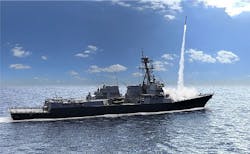Navy asks Raytheon to build three advanced prototype AMDR radar systems for Burke-class surface warship
Officials of the Naval Sea Systems Command in Washington are asking the Raytheon Integrated Defense Systems segment in Marlborough, Mass., to provide three low-rate initial production (LRIP) versions of the AMDR for late-model Arleigh Burke-class (DDG 51) Aegis destroyers.
LRIP means building small quantities of the system to enable Navy experts to test the it thoroughly to ensure it meets Navy requirements. This phase also enables Raytheon to tool-up for full-rate production. LRIP is the first step in switching from customized hand-built prototypes to the final mass-produced end product.
The Raytheon AN/SPY-6(V) AMDR will improve the Burke-class destroyer's ability to detect hostile aircraft, surface ships, and ballistic missiles, Raytheon officials say. The AMDR will supersede the AN/SPY-1 radar, which has been standard equipment on Navy Aegis Burke-class destroyers and Ticonderoga-class cruisers.
Related: Warship radar technology designers set sights on next-generation Navy cruiser
Raytheon prevailed over Northrop Grumman Corp. and Lockheed Martin Corp. to build the AMDR in 2013. The price of each LRIP system typically can be much higher than the final mass production unit cost, since the LRIP price can include research and production setup costs for production.
The AN/SPY-6(V) surface warship radar system will provide greater detection ranges, increased discrimination accuracy, higher reliability and sustainability, and lower costs, compared to the AN/SPY-1D(V) radar onboard today’s Burke-class destroyers.
The new AMDR will go aboard Flight III Burke-class destroyers. Thus far two Flight III Burke-class destroyers are under contract: the USS Jack H. Lucas (DDG 125); and the USS Louis H. Wilson Jr. (DDG 126).
The new Flight III versions of the Burke-class destroyers are under construction at Huntington Ingalls Inc. in Pascagoula, Miss., and at the General Dynamics Corp. Bath Iron Works segment in Bath, Me. Flight III is the latest version of the Burke-class guided missile destroyer.
story continues below
The AN/SPY-6(V) AMDR is built with individual building blocks called radar modular assemblies (RMAs), Raytheon officials say. Each RMA is a self-contained radar in a two-cubic-foot box; RMAs can stack together to form any size array to fit ship mission requirements.
The inherent scalability of the AN/SPY-6(V) AMDR also could enable new instantiations, such as backfits on existing Burke-class destroyers and installation on aircraft carriers, amphibious warfare ships, frigates, the littoral combat ship, and Zumwalt-class land-attack destroyers without significant new radar development costs, Raytheon officials say.
For the Flight III Burke-class destroyer's SPY-6(V) AMDR will feature 37 RMAs. The new radar will be able to see targets half the size at twice the distance of today’s SPY-1 radar. The AMDR will have four array faces to provide full-time, 360-degree situational awareness. Each 14-by-14-foot face is about the same size as today’s SPY-1D(V) radar.
The AN/SPY-6(V) AMDR will 30 times more sensitive than the AN/SPY-1D(V) in the Flight III configuration, and is being designed to counter large and complex raids, Raytheon officials say. The new radar will have adaptive digital beamforming and radar signal processing for dealing with high-clutter and jamming environments.
The AN/SPY-6(V) radar also is reprogrammable to adapt to new missions or emerging threats. It uses high-powered gallium nitride (GaN) semiconductors, distributed receiver exciters, adaptive digital beamforming, and Intel processors for digital signal processing.
The new radar will feature S-band radar coupled with X-band horizon-search radar, and a radar suite controller (RSC) to manage radar resources and integrate with the ship’s combat management system.
On this order Raytheon will do the work in Marlborough, Mass., and should be finished by March 2023. For more information contact Raytheon Integrated Defense Systems online at www.raytheon.com, or Naval Sea Systems Command at www.navsea.navy.mil.
Ready to make a purchase? Search the Military & Aerospace Electronics Buyer's Guide for companies, new products, press releases, and videos
